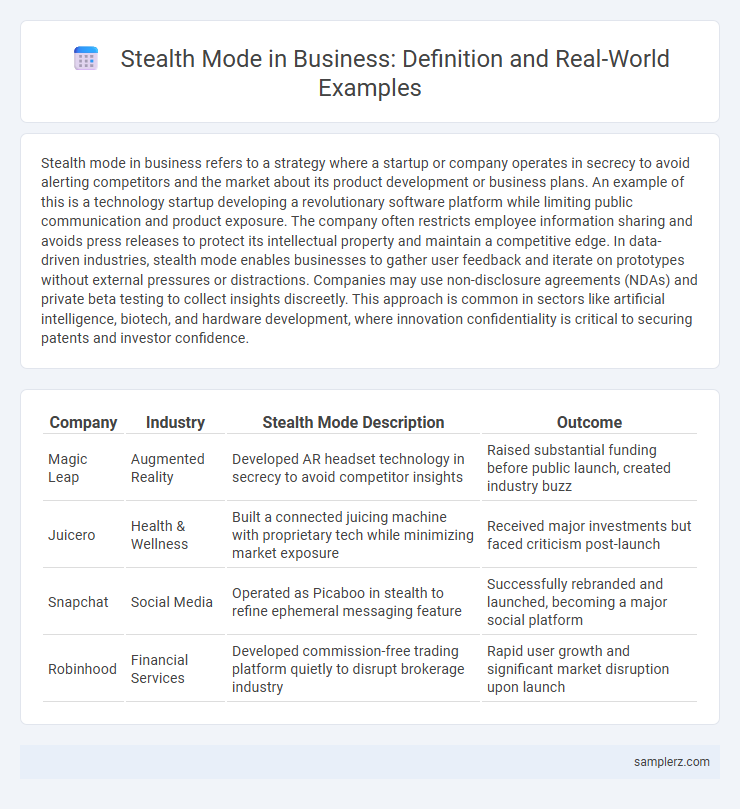Stealth mode in business refers to a strategy where a startup or company operates in secrecy to avoid alerting competitors and the market about its product development or business plans. An example of this is a technology startup developing a revolutionary software platform while limiting public communication and product exposure. The company often restricts employee information sharing and avoids press releases to protect its intellectual property and maintain a competitive edge. In data-driven industries, stealth mode enables businesses to gather user feedback and iterate on prototypes without external pressures or distractions. Companies may use non-disclosure agreements (NDAs) and private beta testing to collect insights discreetly. This approach is common in sectors like artificial intelligence, biotech, and hardware development, where innovation confidentiality is critical to securing patents and investor confidence.
Table of Comparison
| Company | Industry | Stealth Mode Description | Outcome |
|---|---|---|---|
| Magic Leap | Augmented Reality | Developed AR headset technology in secrecy to avoid competitor insights | Raised substantial funding before public launch, created industry buzz |
| Juicero | Health & Wellness | Built a connected juicing machine with proprietary tech while minimizing market exposure | Received major investments but faced criticism post-launch |
| Snapchat | Social Media | Operated as Picaboo in stealth to refine ephemeral messaging feature | Successfully rebranded and launched, becoming a major social platform |
| Robinhood | Financial Services | Developed commission-free trading platform quietly to disrupt brokerage industry | Rapid user growth and significant market disruption upon launch |
Understanding Stealth Mode in Business
Stealth mode in business refers to a strategic approach where startups intentionally operate in secrecy to protect their innovative ideas and maintain a competitive advantage. Companies like SpaceX initially remained in stealth mode to develop groundbreaking aerospace technology without alerting competitors. This method allows businesses to refine products, secure intellectual property, and build market anticipation before public launch.
Key Characteristics of Stealth Mode Startups
Stealth mode startups operate under strict confidentiality to protect innovation and maintain competitive advantage by limiting public exposure and avoiding premature market feedback. Key characteristics include minimal external communication, restricted product disclosure, and often working with a small, trusted team to accelerate development without attracting attention from competitors. These startups prioritize secrecy during the early stages of product development and market strategy formulation to secure intellectual property and refine their business model before public launch.
Real-World Examples of Companies in Stealth Mode
Companies like Magic Leap and Juicero operated in stealth mode to protect their innovative technologies before public launch, maintaining secrecy around product development and strategic plans. Palantir Technologies famously utilized stealth strategies during its early years to refine its data analytics platform while avoiding competitive scrutiny. These real-world examples highlight how businesses leverage stealth mode to gain a market advantage by fostering innovation away from public and competitor attention.
Reasons Businesses Choose Stealth Mode
Businesses choose stealth mode to protect innovative ideas from competitors and safeguard intellectual property during early development stages. This approach minimizes market exposure to avoid premature scrutiny, negative feedback, or potential copycats. Stealth mode also helps companies refine their products discreetly, ensuring a stronger market entry upon launch.
How Stealth Mode Drives Innovation
Stealth mode allows startups like Airbnb and SpaceX to develop groundbreaking products away from competitors' eyes, fostering unique innovation without market pressure. By operating in secrecy, companies protect intellectual property and refine business models, enabling focused research and agile iteration. This approach accelerates breakthrough advancements, as teams experiment freely without external scrutiny or premature feedback.
Challenges Faced in Stealth Mode Operations
Stealth mode operations challenge businesses with limited market feedback, increasing the risk of misaligned product development and delayed customer validation. Confidentiality requirements often restrict collaboration and resource acquisition, slowing innovation and scaling efforts. Navigating competitive intelligence risks demands careful communication strategies to prevent information leaks while maintaining operational agility.
Stealth Mode vs. Public Launch: A Strategic Comparison
Stealth mode in business involves operating in secrecy to develop products or strategies without public attention, allowing startups to refine offerings and secure intellectual property before competitors respond. In contrast, a public launch emphasizes market exposure, customer feedback, and rapid growth but carries risks such as early criticism and competitive threats. Choosing stealth mode can provide a competitive edge by fostering innovation under the radar, while a public launch leverages brand awareness and investor confidence to accelerate scaling.
Notable Success Stories from Stealth Mode
Notable success stories from stealth mode include companies like Uber and Airbnb, which operated in secrecy to refine their disruptive business models before public launch. By maintaining stealth mode, these startups avoided competitive pressures and fine-tuned their technology and user experience. This strategic confidentiality enabled rapid market capture and exponential growth once revealed.
Lessons Learned from Stealth Mode Failures
Stealth mode failures in business, such as Juicero's inability to gain market traction despite extensive secrecy, highlight the risks of over-investing in unproven technology without customer feedback. Companies like Secret Escapes demonstrate the importance of balancing confidentiality with early market validation to avoid misjudging demand. These examples underscore the critical lesson that prolonged stealth mode can lead to misaligned product-market fit and wasted resources.
When to Transition Out of Stealth Mode
Transitioning out of stealth mode occurs when a startup has validated its product-market fit and developed a minimum viable product (MVP) ready for public launch. Founders often choose this phase to attract investors, build brand awareness, and scale operations. Key indicators include securing initial user adoption, refining the business model, and preparing go-to-market strategies.

example of stealth mode in business Infographic
 samplerz.com
samplerz.com